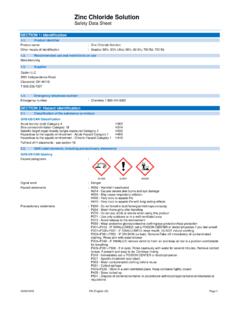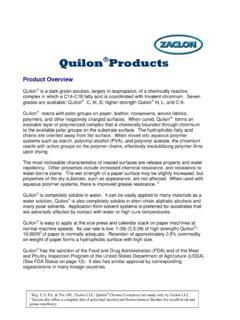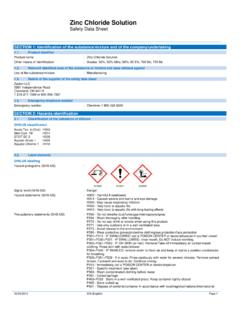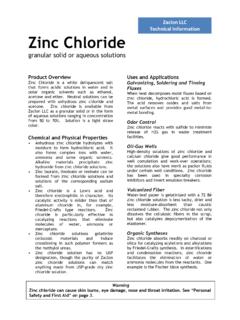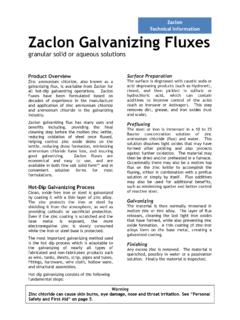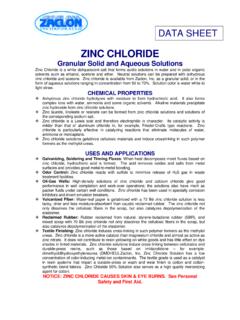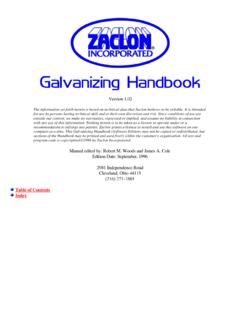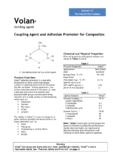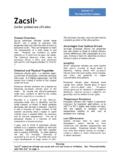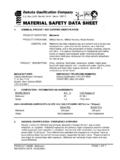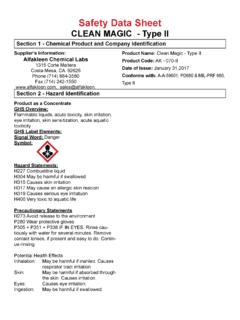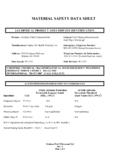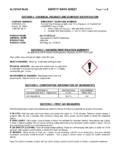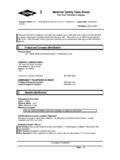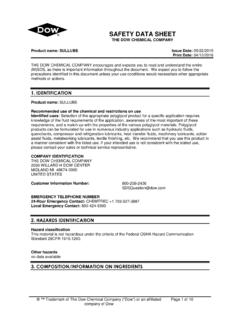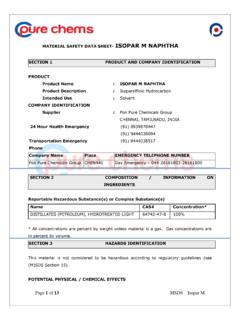Transcription of 1. PRODUCT AND COMPANY IDENTIFICATION - …
1 WETTING AGENT A SAFETY DATA SHEET 1. PRODUCT AND COMPANY IDENTIFICATION PRODUCT identifiers PRODUCT name: Wetting Agent A Relevant identified uses of the substance or mixture and uses advised against Identified uses: Laboratory chemicals, manufacture of substances Details of the supplier of the Safety Data Sheet COMPANY : Zaclon LLC Address: 2981 Independence Road Cleveland, OH 44115 Telephone: 216-271-1569 or 800-356-7327 Emergency Telephone Number: 800-424-9300 2. HAZARDS IDENTIFICATION Classification of the substance or mixture GHS Classification in accordance with 29 CFR 1910 (OSHA HCS) Skin irritation (Category 2), H315 Serious eye damage (Category 1), H318 Skin Sensitisation (Category 2), H317 Specific target organ toxicity- single exposure (Category 3), Respiratory system, H335 For the full text of the H-Statements mentioned in this section, see Section 16 GHS Label elements, including precautionary statements Pictogram Signal Word Danger Hazard Statement(s) H315 Causes skin irritation.
2 H317 May cause an allergic skin reaction. H318 Causes serious eye damage. H335 May cause respiratory irritation. Precautionary Statement(s) P261 Avoid breathing dust/ fume/ gas/ mist/ vapours/ spray. P264 Wash skin thoroughly after handling. P271 Use only outdoors or in a well-ventilated area. P272 Contaminated work clothing should not be allowed out of the workplace P302 + P352 IF ON SKIN: Wash with plenty of soap and water. P304 + 340 IF INHALED: Remove victim to fresh air and keep at rest in a position comfortable for breathing P305 + P351 + P 338 IF IN EYES: Rinse cautiously with water for several minutes. Remove contact lenses, if present and easy to do so. Continue rinsing.
3 P310 Immediately call a POISON CENTER or doctor/ physician. P321 Specific treatment (see supplemental first aid instructions). P333 + P313 If skin irritation or rash occurs: Get medical advice/ attention. P362 Take off contaminated clothing and wash before reuse. P 403 + P233 Store in a well-ventilated place. Keep container tightly closed. P405 Store locked up. P501 Dispose of contents/ container to an approved waste disposal plant. Hazards not otherwise classified (HNOC) or not covered by GHS- none. 3. COMPOSITION/ INFORMATION ON INGREDIENTS SUBSTANCES Component Wetting Agent A Classification Skin Irrit. 2; Eye Dam. 1; Skin Sens. 1; STOT SE 3; H315, H317, H318, H335 Concentration For the full text of the H-Statements mentioned in this section, see Section 16 4.
4 FIRST AID MEASURES Description of first aid measures General Advice Consult a physician. Show this safety data sheet to the doctor in attendance. Move out of dangerous area. If inhaled If breathed in, move person into fresh air. If not breathing, give artificial respiration. Consult a physician. In case of skin contact Wash off with soap and plenty of water. Consult a physician In case of eye contact Rinse thoroughly with plenty of water for at least 15 minutes and consult a physician. Most important symptoms and effects, both acute and delayed The most important known symptoms and effects are described in the labelling (see section ) and/or in section 11. Indication of any immediate medical attention and special treatment needed.
5 No data available. 5. FIREFIGHTING MEASURES Extinguishing media Suitable extinguishing media Use water spray, alcohol-resistant foam, dry chemical or carbon dioxide. Special hazards arising from the substance or mixture Nature of decomposition products not known. Advice for firefighters Wear self contained breathing apparatus for fire fighting if necessary. Further information No data available. 6. ACCIDENTAL RELEASE MEASURES Personal precautions, protective equipment and emergency procedures Use personal protective equipment. Avoid breathing vapours, mist or gas. Ensure adequate ventilation. Evacuate personnel to safe areas. For personal protection, see Section 8. Environmental precautions Do not let PRODUCT enter drains.
6 Methods and materials for containment and cleaning up Soak up with inert absorbent material and dispose of as hazardous waste. Keep in suitable, closed containers for disposal. Reference to other sections For disposal, see Section 13. 7. HANDLING AND STORAGE Precautions for safe handling Avoid contact with skin and eyes. Avoid inhalation of vapour or mist. Normal measures for preventive fire protection. For precautions, see Section Conditions for safe storage, including any incompatibilities Keep container tightly closed in a dry and well-ventilated place. Containers which are opened must be carefully resealed and kept upright to prevent leakage. Specific end use(s) Apart from the uses mentioned in Section , no other specific uses are stipulated.
7 8. EXPOSURE CONTROLS/ PERSONAL PROTECTION Control parameters Components with workplace control parameters Contains no substances with occupational exposure limit values. Exposure controls Appropriate engineering controls Handle in accordance with good industrial hygiene and safety practice. Wash hands before breaks and at the end of the workday. Personal protective equipment Eye/ face protection Tightly fitting safety goggles. Faceshield (8-inch minimum). Use equipment for eye protection tested and approved under appropriate government standards such as NIOSH (US) or EN 166 (EU). Skin protection Handle with gloves. Gloves must be inspected prior to use. Use proper glove removal technique (without touching glove s outer surface) to avoid skin contact with this PRODUCT .
8 Dispose of contaminated gloves after use in accordance with applicable laws and good laboratory practices. Wash and dry hands. Body protection Complete suit protecting against chemicals. The type of protective equipment must be selected according to the concentration and amount of the dangerous substance at the specific workplace. Respiratory protection Where risk assessment shows air-purifying respirators are appropriate use a full-face respirator with multi-purpose combination (US) or type ABEK (EN 14387) respirator cartridges as a backup to engineering controls. If the respirator is the sole means of protection, use a full-face supplied air respirator. Use respirators and components tested and approved under appropriate government standards such as NIOSH (US) or CEN (EU).
9 Control of environmental exposure Do not let PRODUCT enter drains. 9. PHYSICAL AND CHEMICAL PROPERTIES Information on basic physical and chemical properties a) Appearance Form: viscous liquid Color: Colorless b)Odor no data available c) Odor Threshold no data available d) pH no data available e) Melting point/ no data available Freezing point f) Initial boiling point 100 C (212 F) and boiling range g) Flash point no data available h) Evaporation Rate no data available i) Flammability (solid, gas) no data available j) Upper/lower flammability no data available or explosive limits k) Vapor pressure no data available l) Vapor density no data available m) Relative density g/cm3 at 24 C (77 F) n) Water solubility no data available o) Partition coefficient.
10 No data available n-octanol/water p) Auto-ignition temperature no data available q) Decomposition temperature no data available r) Viscosity no data available s) Explosive properties no data available t) Oxidizing properties no data available Other safety information No data available 10. STABILITY AND REACTIVITY Reactivity No data available Chemical stability Stable under recommended storage conditions Possibility of hazardous reactions No data available Conditions to avoid No data available Incompatible materials Strong oxidizing agents Hazardous decomposition products Other decomposition products- no data available In the event of a fire, see Section 5.
